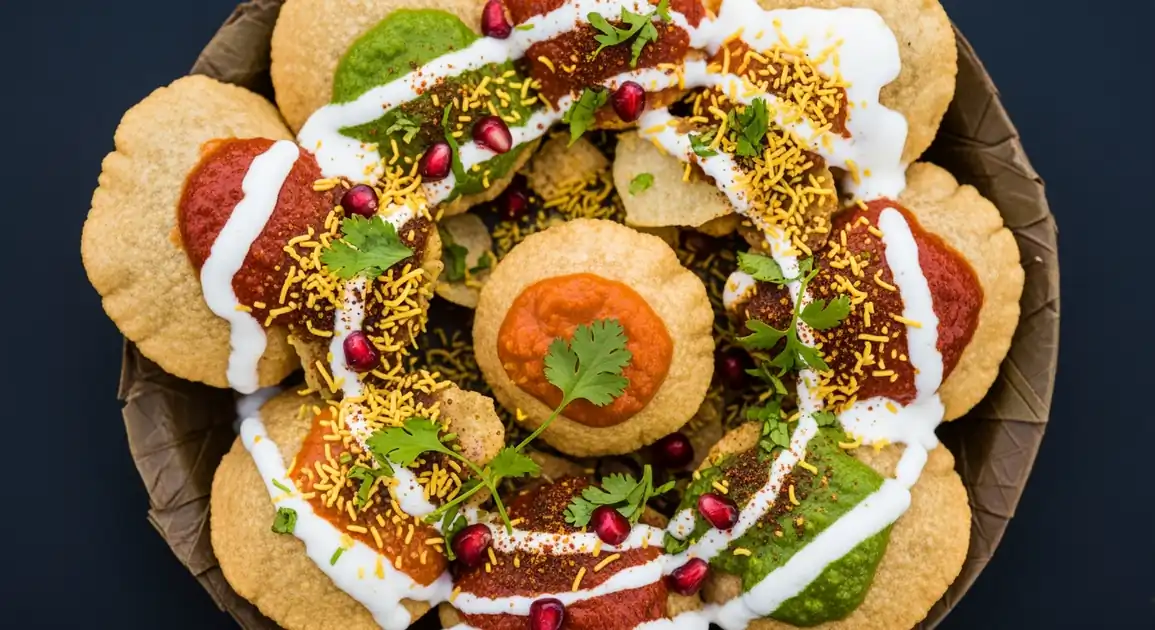Chaat
चाट

Description
Delhi is widely considered the birthplace and capital of chaat culture in India. Its Old Delhi neighborhoods, particularly Chandni Chowk, house generations-old chaat dynasties whose recipes have defined the genre. Delhi chaat is characterized by its bold flavors, generous use of yogurt, and perfect balance between sweet and tangy chutneys. From street corners to specialized chaat houses, the city offers endless variations catering to every preference.
Dietary Information
Serving information
Serving style
Traditional stalls serve on leaf plates (dona/pattal) or paper plates. Many vendors now use small disposable plastic bowls. Most provide wooden or plastic spoons.
Quick facts
Delhi chaat vendors typically operate from 12 PM - 9 PM. Old Delhi vendors may open earlier (11 AM) and close once they run out of ingredients.
Safety Tips
What to Look For
-
Vendor with high turnover and locals in line
Busy stalls ensure ingredients don't sit out long and indicate local approval. Look for vendors serving a steady stream of customers, especially local office workers.
-
Clean preparation area with covered ingredients
Ingredients should be in covered containers, especially yogurt and chutneys. Look for clean surfaces, utensils, and proper refrigeration for perishables.
-
Fresh assembly rather than pre-mixed items
Quality chaat is assembled to order. Watch if the vendor prepares each plate individually rather than serving from a pre-mixed batch.
-
Proper water handling for water-based chaats
For pani puri/golgappa, check if water is stored in clean, covered containers. Better vendors use filtered or bottled water for the flavored water.
-
Separate handling of money and food
Good vendors either have a separate person handling money or use techniques to avoid touching both food and money.
What to avoid
-
Pre-mixed chaats sitting in the open
Avoid vendors who pre-mix ingredients and leave them sitting in open air. This promotes bacterial growth, especially in yogurt-based chaats.
-
Brown or discolored chutneys
Fresh green chutney should be vibrant green. Brownish color indicates it's old or oxidized. Similarly, tamarind chutney should have a glossy appearance.
-
Uncovered water for pani puri/golgappa
The flavored water used in these varieties is high-risk. Avoid if the water looks cloudy or is stored in open containers.
-
Reuse of leftover items
Watch out for vendors who reuse leftover ingredients from previous customers, especially in busy areas.
-
Flies around the stall or ingredients
Indicates poor hygiene. Quality vendors keep their ingredients covered and areas clean to prevent insect contamination.
Price information
Price range
Budget tips
- Old Delhi vendors offer the most authentic experience at 40-70 INR per plate.
- New Delhi markets charge 60-100 INR with slightly better seating conditions.
- Famous spots like Natraj Dahi Bhalle Wala charge premium prices but represent historic recipes.
- Avoid restaurant chaats priced above 150 INR as they rarely match street quality.
Value indicators
- Freshly fried tikkis or papdi rather than pre-fried.
- Hand-ground chutneys rather than commercial ones.
- Generous yogurt that's properly chilled.
- Careful layering of ingredients rather than haphazard assembly.
- Sweet-sour balance without excessive sourness or sweetness.
Where to Find This Dish
Chandni Chowk
The historic heart of Delhi's chaat scene with some stalls dating back generations. Home to iconic establishments like Natraj for dahi bhalle and Jung Bahadur for fruit chaat.
Paranthe Wali Gali, Natraj Dahi Bhalle Wala
Afternoon (12 PM - 4 PM), Evening (4 PM - 8 PM)
Connaught Place
Central Delhi's commercial hub features numerous chaat stalls catering to office workers and shoppers.
Janpath Market, Central Park
Lunch (1 PM - 2:30 PM), Evening (5 PM - 8 PM)
Lajpat Nagar
Popular market area with a concentration of chaat vendors, particularly around the Central Market.
Lajpat Nagar Central Market
Evening (4 PM - 8 PM)
Kamla Nagar
University area with affordable chaat options popular with students.
North Campus (Delhi University)
Afternoon (2 PM - 5 PM), Evening (5 PM - 8 PM)
Vendor Tips
- Ask for 'sukha' (dry) or 'geela' (wet) according to your preference for yogurt quantity.
- Delhi's chaat tends to be spicier than other regions—request 'kam teekha' (less spicy) if needed.
- Watch for vendors who make their own papdi and tikkis rather than using commercial ones.
- Famous vendors often have imitators nearby—confirm you're at the original by asking locals.
How to Order
Regional Variations
-
Delhi-style Golgappa
(दिल्ली वाले गोलगप्पे)
Characterized by cold mint-coriander water with subtle black salt flavor, typically served with a potato-chickpea filling. Delhi vendors often provide multiple waters with varying spice levels.
-
Old Delhi Dahi Bhalle
(पुरानी दिल्ली के दही भल्ले)
Distinguished by their ultra-soft texture achieved through proper soaking, served with thicker yogurt and a unique blend of roasted cumin and red chili powder.
-
Chandni Chowk Papdi Chaat
(चांदनी चौक की पापड़ी चाट)
Features handmade papdi that's larger and crispier than commercial versions, with a distinctive balance of sweet and tangy chutneys.
Cultural context
History
Chaat originated in Delhi around the 17th century when a Mughal emperor's physician recommended spicy, tangy snacks to combat Delhi's polluted water. What began as a health remedy evolved into a culinary tradition, spreading from royal courts to city streets. Regional variations developed as chaat traveled across North India, with each city developing signature styles. Today, chaat represents one of India's most beloved street food categories, with hundreds of variations spanning the subcontinent and reflecting local ingredients, cultural influences, and taste preferences.
Local significance
Chaat in Delhi is more than food—it's a cultural institution. Many families trace their chaat loyalty across generations, with vendors becoming local celebrities. Delhi's chaat culture represents the city's Mughal heritage blended with Hindu vegetarian traditions.
Eating customs
- Delhi-style golgappas are filled with cold, spicy water rather than sweet variants found elsewhere.
- Dahi bhalle should be properly soaked in yogurt—a mark of quality is when it's soft all the way through.
- Papri chaat should be eaten immediately before it becomes soggy.